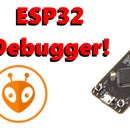Introduction: Easter Egg Hunt With an AM Radio
For Easter this year, I made my kids a pretty unique and fun Easter Egg hunt.
I placed mini radio transmitters built with an ESP32 around my yard that were broadcasting clues where to find the next transmitter, and then eventually the egg haul. For an extra bit of fun, I got some family members who live abroad to record the audio for clues.
My kids, equipped with an AM radio, would have to get the clue and figure out where to go.
They absolutely loved it, I'm already worried how I'm going to top it next year.
This was a very simple project to setup requiring only minimal components and basically no coding, so even if you have no experience making something like this, it is definitely achievable!
Supplies
The Radio
Any Portable AM radio should work, but here are some similar to what I used
- Amazon UK Radio* - Actual one I used
- Amazon US Radio* - Similar
Don't forget the batteries! My radio seemed to work better with non rechargeable batteries.
The Transmitters
You will need one of the following for each transmitter:
- An ESP32 Microcontroller* - These are a type of Arduino style board. There are lots of different types of them, any original "ESP32" based boards will work fine. NOTE: There are other flavors of ESP32 such as the S2, C3 etc, I have not tested on these and you are just best off to stick with just plain old ESP32
- A length of wire to use as an antenna
- Batteries or a power bank for powering the device - This doesn't need to be too big as it does not draw a lot of power or will not be running for long
- Some way of weather proofing it - depends on your climate, but here in Ireland it's pretty wet and I had to use some sandwich bags to keep the devices dry!
You will also need a soldering iron and some solder too attach the wire for the antenna. If you can not solder, it is possible to get ESP32 with pins already soldered on, you can just attach a jumper wire to that (although it will probably not work as well)
Step 1: Check Out the Video!
If your still not sure what the project is about, or you just want to hear some kids having fun, its worth checking out the video!
Step 2: The Inspiration
A few weeks before Easter, I was using an AM radio to find an issue with my robot lawnmower’s boundary wire. My youngest daughter was with me and, as she has absolutely no context to what a portable radio is, she decided that it was “a tracker” like you might see in cartoons.
This kicked my head into gear, how could I turn this into an actual tracker for the Easter egg hunt?
The major obstacle to over come was how would I build the radio transmitter. Radio is typically broadcast over 100s of miles, how would it be possible to place multiple transmitters in just my back yard? It would need to be such a weak transmitter that they wouldn’t clash with each other
Luckily, I remembered Bitluni made a really impressive video a few years back where he created an AM transmitter using just an ESP32 and some wire for the antenna, and while obviously it is not the best transmitter in the world, that was actually a major benefit for this project!
Bitluni’s project page even contained a tool to convert audio files to headers that could be included in the sketch, so unlike most of my projects, I actually didn’t have to write a single line of code for this!
Step 3: Hardware Setup
The only hardware setup that is required is to solder some wire to pin 25 of the ESP32. I cut the wire to be 70cm long, stripped a about half a CM of the sleeve off and soldered it directly to the ESP32 board.
I recomend doing this only for one to begin with, test that and get it working, before doing all of them.
Step 4: ESP32 Setup
If you are not familar with ESP32, they are a microcontroller that are compatible with the Arduino IDE and come with WiFi and Bluetooth included (although we won't be using these features today). They are also quite cheap so they are very useful chips for your projects.
If you haven't already worked with ESP32, you will need to add the ESP32 board definition to your Arduino IDE, to this you can follow the steps listed on the ESP32 Arduino projects Github Page
Step 5: Software Setup & Test
Next we are going to use Bitluni's sample project as test to make sure our setup is working.
To install the project:
- Visit the projects github page
- Click the "Code" button, and then "Download ZIP"
- Extract the Zip
- Click into the extracted folder, and then into the "AMTransmitterI2S" folder
- Open the "AMTransmitterI2S.ino" file with the Arduino IDE
- Plug in your ESP32 via USB
- Under Tools -> Board , select "ESP32 Dev Module"
- Under Tools -> Port, select your devices port
- Upload the code to your board
You should now be able to use your AM radio to hear the same message in Bitluni's code (It's him talking). I tuned my AM radio to around the 900KHz mark to hear it (you will have to play around with this a little)
Once we have this working, we can go onto building the actual hunt!
Step 6: The Sound Recordings
So the plan was to place multiple of these transmitters out in the garden, and each one would broadcast a clue for where to find the next one. So I created clues that would point to a new spot out in the garden.
I have two sisters who currently live abroad, and we thought it might be an extra bit of fun to get them involved, So I got them, and one of their partners, to record the clues. They sent the voice messages on Whatsapp.
To transfer the voice messages from Whatsapp to my PC:
- I clicked on the voice message
- Clicked "share"
- Emailed them to myself
The files were a .opus and needed to be converted to WAV files to be used with Bitluni's tool for converting them. To do the conversion I used Audacity, a free open source audio software.
To convert the files to WAV:
- Open Audacity
- Drag the .opus files into Audacity
- Optional: If there is dead air in the recording you want to get rid of:
- Highlight the potion of audio you want to keep by clicking and dragging your mouse
- Click the "Trim Audio Outside selection" button
- Move your mouse to the top band of the audio clip and it should change into a hand, click and drag the clip to the start of the project.
- Then click File -> Export -> Export as WAV and save it
To convert them to files that can be used in the Arduino project, we will use Bitluni's online tool:
- Visit Bitluni's project page
- Scroll down to the "Audio to Header Converter" section
- Click "Browse" and select the file you want to convert
- It will automatically prompt you where you want to save the header file, you should save it in the "AMTransmitterI2S" folder from the previous step.
Now if you close the Arduino project and open it again, there should be new tabs up the top corresponding with the files you created using the tool. To use them change the line
#include sample.h
to one of the names of the files you generated, so for me "Greenhouse.h"
#include Greenhouse.h
and upload it to the ESP32
Repeat these steps for a new ESP32 for each of the sound recordings (make sure to mark which ESP32 is programmed with what message!)
Step 7: Set Up the Hunt!
You should now be ready to place your devices outside! I left one inside in the Kitchen as a starter clue and placed the rest outside in their spots.
To power the ESP32, I just used a bunch of powerbanks I had left over from the Wedding lights project that surprisingly after 6 years of sitting in a drawer still worked, so I just connected them via micro USB. They only need to be powered for a few minutes though, so you could really power them off almost anything!
Make sure to test the hunt works as expected with the radio before giving it to the kids! (to ensure they are all on and in the correct place)
All you can do now is hope that the kids like it!
Step 8: How Did It Go?
It went really well, they loved it!
For the clues, I was a bit worried right at the start that they seemed to be struggling with the first one, but once they got into it, they flew through them.
From the technical side of things, it also worked pretty well, or at least good enough! None of them malfunctioned so that was good, but some seemed to be a little easier to hear than others.
One of my sisters recorded the messages on their phone, while waiting for a plane to take off, it was sent via whatsapp, transmitted on the most basic of AM transmitters to a 10 euro portable radio so it can’t be too surprising that the audio quality wasn’t amazing.
The kids had a blast though, and that was the main thing! This was really easy to set up because I just used Bitluni’s project exactly as was. Other than writing the clues and asking my sisters to record them, I only started the project after the girls went to bed the night before! I think I spent more time trying to figure out how to get the Audio files from whatsapp and convert them than any other part!
If you’re looking for something fun and a little bit different for the next easter egg or treasure hunt, I can really recommend this. I only used parts I already had here so I’m not sure of an exact cost, but maybe allow $10 for each ESP32 and some way power them and then another $10 or so for the radio, so overall not too expensive.

Participated in the
Battery-Powered Contest













